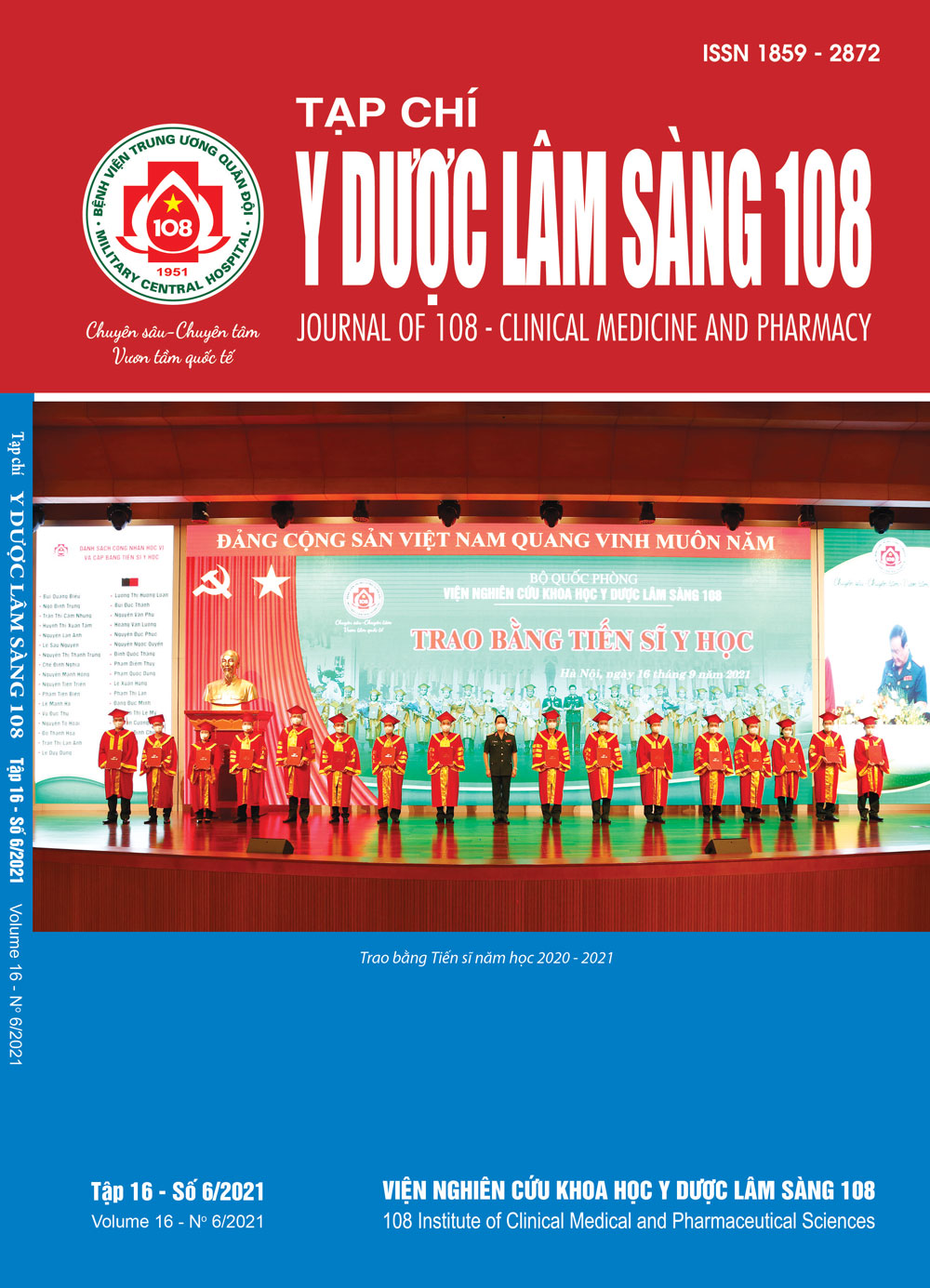Evaluating the complications of following cranioplasty: Incidence and relative factors
Main Article Content
Keywords
Abstract
Objective: To evaluate the complications of cranioplasty after decompressive craniectomy and identify the association of these complications with some risk factors. Subject and method: Retrospective cohort study of 202 patients from August 2018 to January 2021, who had undergone decompressive craniectomy followed by cranioplasty at 108 Military Central Hospital. All patients were followed up to 6 months after cranioplasty and complications were recorded both by imaging and clinically. The major complications were recorded and evaluated in relation to a number of risk factors: Reason for craniectomy, comorbidities (hypertension, diabetes mellitus, anticoagulation), location of cranioplasty, duration from decompressive craniectomy to cranioplasty. Algorithms used for analysis include Student's t-test, Chi-square tests and Fisher's exact tests. Confidence intervals were calculated as the 95% CI. Result: The overall postoperative complication rate was 23.26%. The common complications included: Infection (6.44%), graft collapse (6.44%), seizures (6.44%), bleeding (3.46%). The early cranioplasties (within 3 months after decompressive craniectomy) and disturbance of cerebro - spinal fluid circulation were risk factors for increased postoperative complication rate (p<0.05). Some factors related to common complications: Early cranioplasty (< 3 months) was related to infection and graft collapse with p<0.05, late cranioplasty was associated with postcranioplasty seizure (p=0.007). The disturbance of spinal fluid circulation was associated with postcranioplasty seizure and bone flap resorption (p<0.05). Conclusion: Although cranioplasty is a simple surgical procedure, it is usually associated with a relatively high complication rate. Control of a patient’s risk factors and early recognition of complications may help practitioners avoid the exhaustive list of complications.
Article Details
References
2. Zanaty M, Chalouhi N, Starke R, Clark S, Bovenzi C, Saigh M, Schwartz E (2015) Complications following cranioplasty: Incidence and predictors in 348 cases. J Neurosurg March 13.
3. Lee L, Ker J, Quah BL, Chou N, Choy D, Yeo TT (2013) A retrospective analysis and review of an institution’s experience with the complications of cranioplasty. Br J Neurosurg 27: 629-635.
4. Wachter D, Reineke K, Behm T, Rohde V (2013) Cranioplasty after decompressive hemicraniectomy: Underestimated surgery-associated complications? Clin Neurol Neurosurg 115: 1293-1297.
5. Basheer N, Gupta D, Mahapatra AK, Gurjar H (2010) Cranioplasty following decompressive craniectomy in traumatic brain injury: Experience at level-I. Indian J Neurotrauma 7: 140-144.
6. Sobani ZA, Shamim MS, Zafar SN, Qadeer M, Bilal N, Murtaza SG et al (2011) Cranioplasty after decompressive craniectomy: An institutional audit and analysis of factors related to complications. Surg Neurol Int 2: 123.
7. Saraj S, Rakesh S, Kapil J, Bipin W (2019) Cranioplasty following decompressive craniectomy - Analysis of complication rates and neurological outcomes: A single center study. Surgical Neurology International 10(142).
8. Walcott BP, Kwon CS, Sheth SA, Fehnel CR, Koffie RM, Asaad WF et al (2013) Predictors of cranioplasty complications in stroke and trauma patients. J Neurosurg 118: 757-762.
9. Cheng YK, Weng HH, Yang JT, Lee M, Wang T, Chang C (2008) Factors affecting graft infection after cranioplasty. J Clin Neurosci 15: 1115-1119.
10. Taco Goedemans, Dagmar Verbaan, Maarten Bot, Jantien Hoogmoed et al (2020) Complications in cranioplasty after decompressive craniectomy: Timing of the intervention. Journal of Neurology 267: 1312-1320.
11. Fu-Yuan Shiha, Chia-Cheng Lina, Hung-Chen Wanga, Jih-Tsun Hoa, Chih-Hsiang Linb, Yan-Ting Lub, Wu-Fu Chena, Meng-Han Tsaib (2019) Risk factors for seizures after cranioplasty. Seizure: European Journal of Epilepsy 66: 15-21.
12. Nasi D, Dobran M (2020) Can early cranioplasty reduce the incidence of hydrocephalus after decompressive craniectomy? A meta-analysis. Surgical Neurology International 11: 94.
13. Young-Mook Kim, Taejoon Park, Sang-Pyung Lee, Jin-wook Baek, Kyoung-Soo Ryou, Seong-Hwan Kim (2020) Optimal timing and complications of cranioplasty: A single-center retrospective review of 109 cases. J Neurointensive Care 3(2): 48-57.
14. Tor Brommeland, Nicolay Rydning, Are Hugo Pripp and Eirik Helseth (2015) Cranioplasty complications and risk factors associated with bone flap resorption. Scandinavian Journal of Trauma, Resuscitation and Emergency Medicine 23: 75.
15. Schuss P, Vatter H, Oszvald A, Marquardt G, Imöhl L, Seifert V et al (2013) Bone flap resorption: Risk factors for the development of a long-term complication following cranioplasty after decompressive craniectomy. J Neurotrauma 30: 91-95.
 ISSN: 1859 - 2872
ISSN: 1859 - 2872
